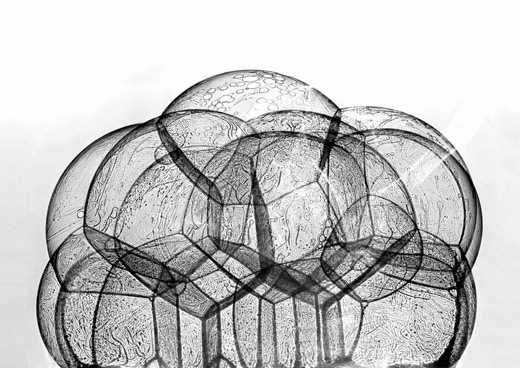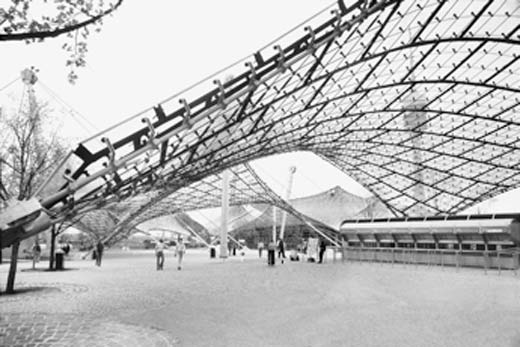Form follows nature at the Kunsthaus Kaufbeuren, Allgäu, Germany
Just as the devil has the best tunes so does nature posses all the best structural forms. Consequently engineers and designers have long looked to nature for inspiration, the results being as varied, mundane and ultimately important as Velcro, turbines and even train noses.
The secret of course is knowing where to look. The early “bird men”, for example, thought flight was all about flapping. It isn’t. It’s about air flows, keel-shaped sternums and hollow bones. Once that had been understood there was no stopping the pioneers of flight.
Architects obviously also look to nature for answers to seemingly insurmountable problems and/or inspiration, and an exhibition in the Kunsthaus Kaufbeuren near Kempten in Allgäu currently celebrates one of the masters of biomimicry in architecture, one of those men who best understood where to look, the German architect Frei Otto.
Born in Chemnitz on May 31st 1925 Frei Otto studied architecture at Berlin Technical University before in 1950 a bursary from the “Studienstiftung des deutschen Volkes” took him to America where in addition to studying sociology and urban planning at the University of Virginia he met with the likes of Eero Saarinen, Ludwig Mies van der Rohe, Frank Lloyd Wright or Charles and Ray Eames. Following his return to Berlin Frei Otto established his own architectural practice in 1952 followed in 1954 by the completion of his PhD thesis “Das hängende Dach” – “The suspended roof”.
Inspired by the ideas being developed by the architects he had met in America Frei Otto became interested in developing organic, light structures which were part of the natural environment rather than an imposition. For all suspended structures. In Das hängende Dach Frei Otto notes that “The modern suspended roof is the newest construction form. Complete and inclusive it claims its place. It is architecture – is a building”1 And spent the next 150 pages, and indeed the rest of his career, demonstrating just that.
In 1958 Frei Otto established the private Entwicklungsstätte für den Leichtbau – Institute for the Development of Lightweight Construction – in Berlin before moving to Stuttgart in 1968 where he established the Institute for Lightweight Structures at the Technische Hochschule Stuttgart, an institution which he led until retiring in 1991. In the course of his work Frei Otto collaborated with biologists, anthropologists, physicists and related scientists to investigate how natural structures could be best transferred to architecture. Much like Fritz Haller Frei Otto was largely a theoretical architect, one who did a lot of planning, thinking, experimenting. But less actual building. Those works he did realise however generally stimulating approval and affection in all who experience them. Among Frei Otto’s most famous constructions are the so-called Tanzbrunnen stage developed for the 1957 Bundesgartenschau horticultural festival in Cologne, the German Pavilion for Expo 1967 in Montreal, Canada and the roof of the 1972 Olympic Stadium in Munich. More recently Frei Otto was involved with, for example, the development of the roof for the new central station in Stuttgart and the Japanese Pavilion for Expo 2000 in Hannover, a project realised in collaboration with Shigeru Ban. Frei Otto’s most “exotic” work probably remains a series of dynamic parasols he developed for Pink Floyd’s 1977 US tour. In addition to teaching in Stuttgart Frei Otto also served tenures as a guest lecturer at institutes as varied as, for example, Washington University in St. Louis, the Massachusetts Institute of Technology and the Hochschule für Gestaltung Ulm and published numerous standard architectural works.
Presenting 25 models of projects by and from Frei Otto complimented by sketches, photos and a collection of inspiration giving natural materials, Form follows nature promises not only to explore how Frei Otto utilised nature to create his constructions but also explain how through such research he approached his ideal of building economically, ecologically but for all in harmony with nature.
In addition to Frei Otto Form follows nature also presents works by Stephanskirchen based Finsterwalder Architects and the German artist Carsten Nicolai, thus complementing Frei Otto’s canon with alternative, contemporary, interpretations of the use of natural structures in creative form giving processes.
Form follows nature runs at the Kunsthaus Kaufbeuren, Spitaltor 2, 87600 Kaufbeuren, Allgäu, Germany until Sunday November 16th.
Full details, including information on the accompanying fringe programme, can be found at www.kunsthaus-kaufbeuren.de
1. Frei Otto, Das hängende Dach, Im Bauwelt Verlag, Berlin, 1954
Tagged with: Allgäu, Frei Otto, Kempten, Kunsthaus Kaufbeuren

